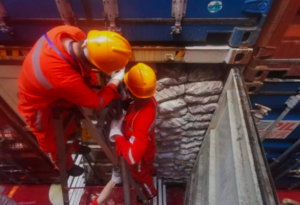The Charity
Aviation
Maritime
M2156/58

Initial Report
CHIRP received two cargo stowage-related reports with similarities in causation.
- Leakage of jerricans was caused by improper packing. No dunnage plate had been fitted between layers of jerricans, resulting in the excess weight crushing the lower jerrican tiers. The jerricans were filled with the corrosive substance UN 2789 acetic acid. The leakage caused severe damage to the container interior.
- Four containers loaded onto the vessel were found emitting smoke during the voyage. The cargo was declared as DG, UN1361 Charcoal. The vanning inspection report indicates the charcoal was packed according to IMDG Code. Still, an inspection reveals a significant air space above the charcoal bags allowing more air in the container to react with the charcoal, which self-heated as a consequence.
CHIRP Comment
In the jerry-can example weight distribution was not properly considered during the vanning operation, which led to issues during the voyage. Using good quality plywood sheeting to distribute the weight of the jerry cans is a recommended practice. This helps to evenly distribute the load of each tier, reducing the chances of movement and potential damage. Additionally, using dunnage within the container prevents cargo shifting within the container. It is also good practice to provide a photo of containers once they have been loaded. This is very valuable for crews in the event of an emergency because it significantly enhances their situational awareness without having to open the container.
The second incident also highlights the importance of packing cargoes, and particularly Dangerous Goods cargoes, correctly. The International Maritime Dangerous Goods Code (IMDG Code) and the Code of Safe Practice for Cargo Stowage and Securing (CSS Code) provide useful guidance on the proper handling, packaging, stowage, and securing procedures to minimise the risk of accidents and protect the crew, the vessel, and the environment.
Bagged charcoal should be left to cool for at least 14 days before packaging, protected from moisture, and placed in sift-free and robust bags without tears. The bags should withstand the weight of other bags stacked on them. Temperature control is also crucial, with the cargo not exceeding 5 degrees above the ambient temperature during the loading process.
All parties involved in the transportation process, including the carrier, charterers, and freight forwarders, should recognise and demand that good stowage practices are followed. Better training and enforcement of the regulations can help prevent accidents, protect personnel, and safeguard the environment.
Key Issues relating to this report
Local Practices– Charterers should ask demanding questions of shippers and freight forwarders. Is the stowage in accordance with industry and seamanship standards? A photograph is a very powerful medium to confirm that this is the case.
Communications- Do the vessel managers have enough information to determine the risks for the DG’s being carried?
Capability- Ensure the management teams have enough resources to manage the carriage of DG cargoes: inadequate resources can lead to dangerous shortcuts. Is your company’s DG team adequately resourced and skilled to meet the demands placed on them?
Teamwork- Effective supply chain teamwork was not apparent in either of these incidents.
This data type is not supported! Please contact the author for help.






